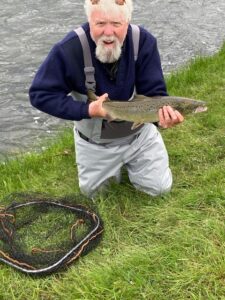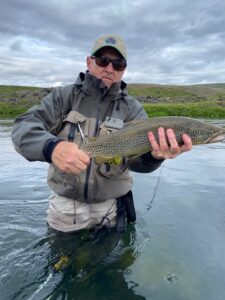In July, a group of my fishing buddies flew to Iceland to do some Atlantic Salmon, Brown Trout and perhaps Arctic Char fishing. Included in the group were Mike Shepard of Dalton, Mike Miller and Carlton Racie from Athol, MA, Darren Miller from Bedford, MA, Brandon Jones of Leominster, MA, Gary Hebert of Richmond, NH, Tim Racie from Acton, MA and Ken Griffin from Boston.
Their trip to Iceland started on July 21, flying out of Boston to Reykjavik, the largest city and capitol of Iceland. Following an overnight stay there, they flew to Akureyri, a fishing village in northern Iceland. There they were picked up by their outfitter, Iceland Fishing Guide, and drove to Myrarkvisl Lodge.
Before fishing Iceland’s waters, all of their fishing equipment including rods, reels, flies, fly lines, waders and boots had to be disinfected in order to protect the pristine Icelandic rivers from any risk of infection from bacteria or disease from foreign rivers that may be present on waders or other equipment.
The Mýrarkvísl River is one of the tributaries of Laxá River in Aðaldal, which flows north into the Atlantic Ocean near the Arctic Circle. It is a relatively small river that holds a great stock of brown trout along with good runs of Atlantic Salmon throughout the summer. The river runs through plains on the Reykjaheiði plateau making it perfect for fly fishing. All of their fishing was done on private land owned by farmers which the guide rented for fishing beats. They fished on this river for three days.
On the second day, Mike Shepard caught an 8 lbs female (hen) Atlantic salmon that was fresh from the ocean and “as silver as it could be.” It took him about 30 minutes fighting it in heavy water. As soon as he could get her to shore for the guide to net, she would line him. (make another powerful run). She did this 4 – 5 times. In the process, she jumped 5 times, straight out of the water. Mike’s biggest issue was if she chose to leave the pool, there was no way he could follow her down the river for it was really rough walking. However; he was using an Orvis Helos III 9 weight (heavy, strong rod) a Mirage Reel and 20 lbs test straight leader, and was able to turn her back to the pool easily.
For salmon, they normally use heavy tube flies or classic Atlantic salmon flies, size 10 with double hooks. But Mike caught her on a dark colored dry fly.
They then switched to the Reykjadalsa Lodge, in a small village of Laugar in northern Iceland. There they fished the balance of the days in the Reykjadalsa River, a typical freestone river, renowned for salmon fishing and a wet fly angler’s paradise. It’s known as one of Iceland’s best wild Trout rivers, with high volumes of fish landed every season. In the morning, four of their group fished for Atlantic Salmon, and in the afternoon, they switched and fished for big Brown Trout in the Laxa River. They split the trip into two different lodges for the logistics of fishing different rivers and streams.
The Laxa River is about 3/4 of a mile wide and never deeper than one’s knees, so one could wade straight across it. The river bottom was black, from volcanic ash and it is full of big Brown Trout. (Iceland is basically a volcanic island. All the volcanic activity that is in the news these days is in the south about 200 miles from where they currently were staying).
The smallest Brown Trout caught on the trip was probably 3lbs and the largest 7lbs. There is not an abundance of aquatic insects so a dry-fly fisherman had to work hard to catch them. On the other hand, a wet-fly fisherman or person fishing with nymphs could kill them. (Actually, everything was “catch & release).
According to Mike Shepard, they got their share of rainy, windy weather. He wore Under Armour, a flannel shirt, and a wool sweater each day, and a raincoat, too, if needed.
They never got to see the Northern Lights and because of the long days up there, they fished until 10:00 pm, had an hour’s drive back to the lodge and didn’t eat until 11:30 pm.
According to Mike, all in all, the group caught a lot of big brown trout. They caught 13 Atlantic Salmon Most of the guys caught one or two, but Carl’s son Tim Racie is an accomplished wet-fly fisherman, and caught 4, one of which was a brute of probably 20 lbs. The guide said it was the biggest one caught in the river in the last 4-5 years. Gary Hebert managed to hit the mother lode on Browns and caught one of the largest Browns of the week.
According to Gary, they have a tradition up there when you catch your first Atlantic Salmon of the season, you have to indulge in the curse of the fermented shark (a tradition of having to eat fermented shark (Hakari). He described it as the nastiest rotten smelliest vile food in the world.
(Readers may remember Gary. I mentioned him in an article that I did about fishing the Minipi River/Lake in Labrador some years back. He and I were the early risers each morning and he would make our coffee, which was arguably the strongest cup of coffee in North America. We called it napalm. Both being vets, we got a chuckle out of that.)
They were in a small village of Laugar in northern Iceland. The country is essentially run on geothermal power. According to Gary, a few of them indulged in one of the local geothermal pools while enjoying their favorite libations.
Mike Shepard feels that it is clearly a “bucket list” trip – the opportunity to catch an Atlantic Salmon is once in a lifetime. Although he only caught one, he did have ten come after his fly – three with the intention of hitting it. One, estimated to be 15 pounds came right out of the river and jumped over his fly. Another big one hit it with his nose and knocked it straight up in the air. The other salmon flashed at his fly, not making any effort to take the fly. Atlantic Salmon don’t eat once they hit fresh water, so you are left to making them mad.
“The country is essentially treeless, mountains with enormous valleys of grass fields and outcropping of volcanic rock”, said Mike, “unique but beautiful in its own pristine way. The Icelandic people are very friendly and helpful, the guides were excellent. The food was traditional Icelandic meals focusing on lamb and fish. One of the cooks was a trained chef so dinner was gourmet.”
The trip took 10 days including travel days and an overnight stay in Reykjavik. The price was $6,400 USD per person for 6 1/2 days of fishing, which included meals, fishing license, guiding (1 guide for two anglers), accommodations, full catering, taxes and tips. Airfare was $860 with another approximately $650 for hotel, meals, libations, taxes and tips.
Incidentally, of the 8 anglers who went on that trip, 5 came back with Covid. Fortunately for Mike Shepard, he was not one of them.
In case you are wondering why I didn’t join the guys on this trip, its because my wife Jan and I were in other waters – the Mediterranean Sea on a cruise ship. While there, I was hoping to do a little trolling off of our stateroom balcony (on the 14th deck), but it just didn’t work out. The handle of my net was a tad too short.
Fishing Derby
The Friends of the Berkshire Hatchery in Hartsville-New Marlborough is scheduled to have its last Youth Fishing Derby of this year next Saturday, September 14 from 9:00 to 10:30 am at its Lower Pond at the Berkshire National Fish Hatchery, 240 Hatchery Road, Hartsville, MA. Children aged 13 and under must be accompanied by an adult. No child goes away empty handed.
Wear your life jackets, it’s the law
MassWildlife cautions us that all canoe or kayak occupants must wear a U.S. Coast Guard approved PFD from September 15 to May 15, and that includes waterfowl hunters.


